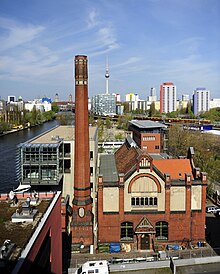Sewage pumping station

Sewage pumping stations or sewage lifts are technical devices for the forced transport of sewage from separating or mixed water systems. They consist of the building shell , transport equipment and electrical, measurement, control, regulation and often data transmission technology.
Various methods, such as hydraulic and pneumatic systems, make it possible to search for object-specific solutions that allow the wastewater to be transported in a state that it remains capable of being clarified and that the environment is not polluted by odor and dangerous gases.
The transport of sewage over many kilometers and pressure pipe networks is possible.
Several processes can be used, which are divided into the process groups "hydraulic waste water delivery" and "pneumatic waste water delivery". There are also mixed processes.
In hydraulic sewage pumping, there are direct and indirect methods that work with flow or displacement machines. Pneumatic waste water pumping works with either positive or negative pressure.
Wastewater pumping with combined hydraulic and pneumatic processes and supplementary processes.
All processes for pumping wastewater have their basic advantages and disadvantages, which are in the following points:
- Efficiency / energy consumption
- Investments
- Maintenance facility
- operating cost
- Mastery of problems such as the formation of sulphides in the system, pressure surge compensation, solid transport, adaptability to changed media conditions and changed quantities
- Space requirement
- Downtimes
- Hygienic aspects
- Overall economy
The above-mentioned sulphides in wastewater systems are often the cause of odor nuisance for residents or retailers, the occurrence of mortal hazards for the operating personnel and the destruction of fixed assets through biogenic corrosion.
The reasons for this can be (indirect) introduction of odorous substances and sulphides or the formation of odorous substances and sulphides in the sewage system.
A sulphide balance for the wastewater must be drawn up during planning. The volatile sulphide in the dissociation form of H 2 S smells badly like rotten eggs even in low concentrations (perceptible limit concentration 0.075 ppm ); it is a very toxic, highly hemotoxic gas (danger to life) and is the starting product for the formation of sulfuric acid on the walls of sewage systems - cause of biogenic corrosion.
The processes described can currently be prevented / mastered by around 100 practicable variants of the most diverse physical, chemical and biological modes of action, with active and passive methods, preventive and curative, so that the transport with sewage pumping stations is no higher in relation to the problems described above Must mean risk.
literature
- D. Weismann, T. Gutzeit: Municipal sewage pumping stations. 2nd edition, VULKAN-Verlag, Germany 2006, ISBN 978-3-8027-2843-3
- D. Weismann, M. Lohse: Sulfide Praxishandbuch der Abwassertechnik; Prevent odor, danger and corrosion and control costs! 1st edition, VULKAN-Verlag, Germany 2007, ISBN 978-3-8027-2845-7
